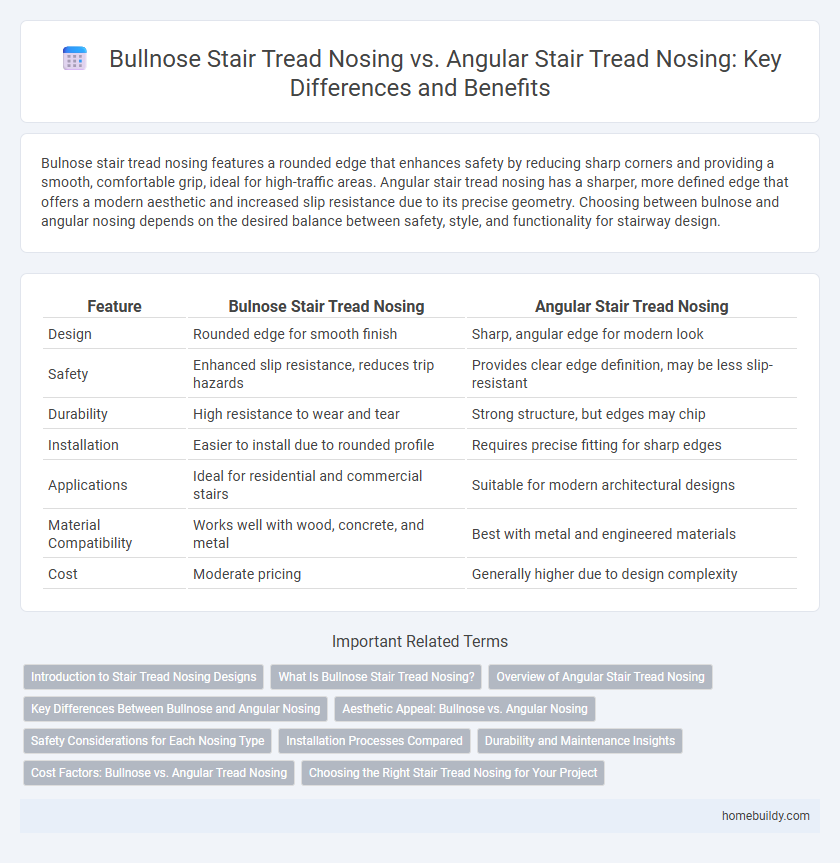Bulnose stair tread nosing features a rounded edge that enhances safety by reducing sharp corners and providing a smooth, comfortable grip, ideal for high-traffic areas. Angular stair tread nosing has a sharper, more defined edge that offers a modern aesthetic and increased slip resistance due to its precise geometry. Choosing between bulnose and angular nosing depends on the desired balance between safety, style, and functionality for stairway design.
Table of Comparison
| Feature | Bulnose Stair Tread Nosing | Angular Stair Tread Nosing |
|---|---|---|
| Design | Rounded edge for smooth finish | Sharp, angular edge for modern look |
| Safety | Enhanced slip resistance, reduces trip hazards | Provides clear edge definition, may be less slip-resistant |
| Durability | High resistance to wear and tear | Strong structure, but edges may chip |
| Installation | Easier to install due to rounded profile | Requires precise fitting for sharp edges |
| Applications | Ideal for residential and commercial stairs | Suitable for modern architectural designs |
| Material Compatibility | Works well with wood, concrete, and metal | Best with metal and engineered materials |
| Cost | Moderate pricing | Generally higher due to design complexity |
Introduction to Stair Tread Nosing Designs
Bulnose stair tread nosing features a rounded edge that enhances safety by reducing sharp corners and providing a comfortable step transition, making it ideal for high-traffic areas. Angular stair tread nosing offers a clean, sharp edge that complements modern architectural designs and allows for precise installation on straight stair edges. Both designs improve stair durability and slip resistance but cater to different aesthetic and functional requirements.
What Is Bullnose Stair Tread Nosing?
Bullnose stair tread nosing features a rounded edge that enhances safety by reducing sharp edges and providing a smooth finish on stair steps. This design improves durability by minimizing wear on the edges and offers a classic aesthetic appeal commonly used in residential settings. Compared to angular stair tread nosing, bullnose nosing delivers a softer, more ergonomic surface that helps prevent trips and falls.
Overview of Angular Stair Tread Nosing
Angular stair tread nosing features a sharp, defined edge designed to enhance slip resistance and improve safety in high-traffic areas. This type of nosing is commonly made from durable materials such as aluminum or rubber, offering long-lasting wear and resistance to impact. Its design provides a contemporary aesthetic while clearly defining the step edge to prevent trips and falls.
Key Differences Between Bullnose and Angular Nosing
Bullnose stair tread nosing features a rounded edge that enhances safety by reducing sharp corners and providing a softer transition on stair steps, making it ideal for high-traffic commercial and residential areas. Angular stair tread nosing has a sharp, defined edge that offers a contemporary look and better grip, often preferred in industrial or modern architectural designs. The key differences lie in the edge shape, safety characteristics, and aesthetic appeal, where bullnose prioritizes comfort and durability, while angular nosing emphasizes style and slip resistance.
Aesthetic Appeal: Bullnose vs. Angular Nosing
Bullnose stair tread nosing offers a smooth, rounded edge that enhances aesthetic appeal by creating a softer, more traditional look ideal for residential or classic interior designs. In contrast, angular stair tread nosing provides sharp, clean lines that contribute to a modern, minimalist appearance favored in contemporary commercial spaces. Choosing between bullnose and angular nosing significantly impacts the visual harmony and style consistency of staircases in various architectural settings.
Safety Considerations for Each Nosing Type
Bulnose stair tread nosing provides enhanced slip resistance due to its rounded edge, reducing the risk of trips and falls on staircases in both residential and commercial settings. Angular stair tread nosing offers a defined edge that improves visibility and grip but may present a sharper corner that can pose a higher injury risk in case of a fall. Selecting the appropriate nosing depends on balancing slip resistance, impact safety, and compliance with local building codes and ADA requirements.
Installation Processes Compared
Bulnose stair tread nosing features a rounded edge that allows for straightforward installation with standard adhesive and finishing methods, reducing labor time on site. Angular stair tread nosing requires more precise measurement and secure fastening due to its sharp edges, often necessitating additional tools or specialized fasteners to ensure durability. While bulnose nosing offers an easier fitting process, angular nosing provides a more precise alignment challenge during installation.
Durability and Maintenance Insights
Bulnose stair tread nosing offers enhanced durability due to its rounded edges, which resist chipping and wear better than angular designs. The smooth, curved surface of bulnose profiles requires less frequent maintenance and cleaning, reducing long-term upkeep costs. Angular stair tread nosing, with sharp edges, tends to show signs of damage more quickly and demands more regular inspections and repairs to maintain safety and appearance.
Cost Factors: Bullnose vs. Angular Tread Nosing
Bullnose stair tread nosing typically incurs higher costs due to its rounded edges requiring more material and intricate manufacturing processes compared to angular nosing's straight, simpler design. Material choice significantly influences price, with hardwood or metal bullnose options costing more than standard angular profiles made from aluminum or rubber. Installation expenses also vary, as bullnose nosing demands precise fitting to maintain smooth curvature, whereas angular nosing installation tends to be quicker and more straightforward, reducing labor costs.
Choosing the Right Stair Tread Nosing for Your Project
Bulnose stair tread nosing features a rounded edge that enhances safety by reducing trip hazards and provides a classic aesthetic ideal for residential and commercial spaces. Angular stair tread nosing offers a sharp, precise edge, promoting a modern look and better visibility on stair edges, which is essential in high-traffic or industrial environments. Selecting the right stair tread nosing depends on factors like safety requirements, design preferences, and the specific use case of the stairway, ensuring durability and compliance with local building codes.
Bulnose stair tread nosing vs angular stair tread nosing Infographic

 homebuildy.com
homebuildy.com